Google Ads vs LinkedIn Ads: A Comprehensive Comparison
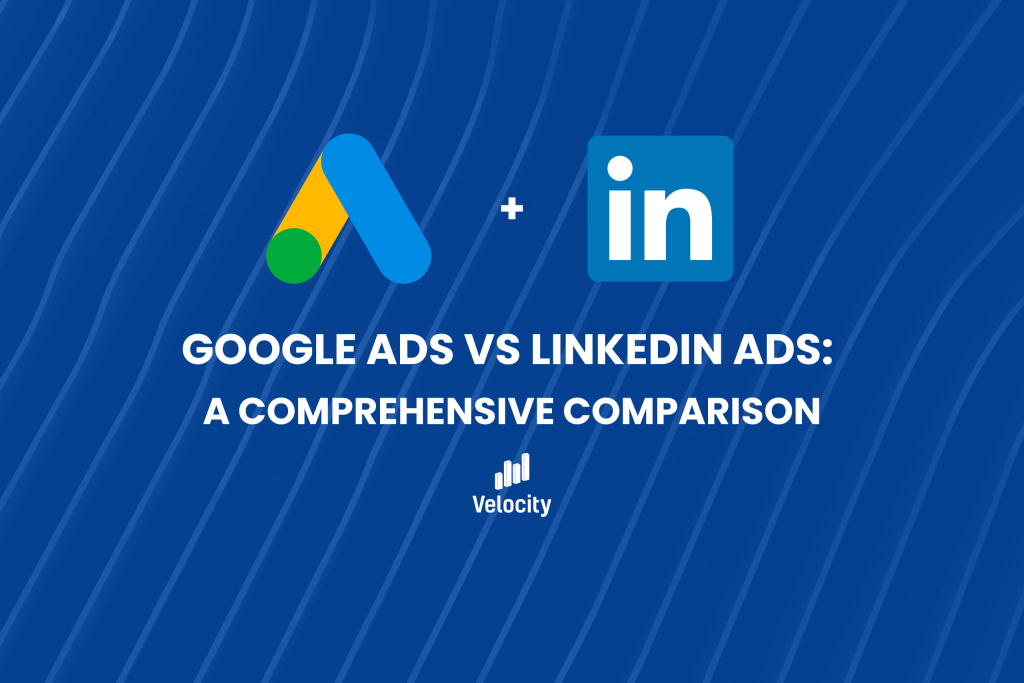
Two household names, two powerful advertising channels. A battle for the ages. But which is a better fit for your business, and why?
In this post we’ll take a look at Google Ads and LinkedIn Ads, comparing ad formats, use-cases and the benefits and limitations of each channel. Our thorough comparison will help you determine which one is best suited to your advertising goals.
Both channels are deadly-effective customer acquisition channels. But for very different reasons. Read on for our deep dive:
What are the main differences between Google Ads and LinkedIn ads?
Intent-based vs. discovery-based ad targeting
Google Ads and LinkedIn Ads differ in terms of their advertising mechanics. Google Ads is intent-based, meaning that it targets users who are actively searching for specific products or services. Given that Google is the world’s most popular and effective search engine, it gives advertisers enormous reach.
Advertisers bid on keywords related to their business, and their ads appear on the search engine results page when users enter those keywords. This approach allows businesses to reach potential customers who are already interested in what they have to offer.
On the other hand, LinkedIn Ads are discovery-based. Instead of targeting users based on their search intent, LinkedIn Ads focus on reaching a specific audience based on their professional profiles, job titles, industries, and other professional characteristics. This approach allows businesses to target a particular demographic or industry, even if the users are not actively searching for their products or services.
While Google Ads can be effective in capturing users who are actively looking for something specific, LinkedIn Ads can be valuable for businesses looking to reach a specific professional audience or promote their brand among professionals in a particular industry.
The choice between the two platforms really depends on your marketing objectives and the target audience of your business, we’ll get more into this difference later, to help you decide which is a better fit.
Cost Per Click
In general, LinkedIn ads tend to have higher CPCs (Cost Per Click) compared to Google Ads. This is primarily because LinkedIn is a professional networking platform that targets a specific audience of professionals and businesses.
The targeting options on LinkedIn are more specific and allow advertisers to reach professionals based on their job titles, industries, and skills. Due to the niche nature of LinkedIn’s audience, there is often higher competition among advertisers to reach this valuable audience, driving up the CPCs.
On the other hand, Google Ads caters to a broader audience and has a larger reach, resulting in lower CPCs on average.
However, it is important to note that the actual CPCs on both platforms can vary a lot depending on various factors such as ad relevance, bidding strategy, and industry competition. While Google overall has generally lower CPCs, some industries like Law, Insurance, Loans and Mortgages have seriously high search ad CPCs due to heavy competition.
Reach
The reach on Google Ads and LinkedIn Ads varies significantly due to the differences in their respective platforms and user bases.
Google Ads has a vast reach as it is the most popular search engine globally, with billions of users conducting searches every day. This allows advertisers to target a wide range of audiences based on keywords, interests, demographics, and location.
On the other hand, LinkedIn Ads primarily target professionals and businesses, offering a more niche audience with a focus on B2B marketing. This platform allows advertisers to target specific industries, job titles, company sizes, and more.
While Google Ads may provide a broader reach, LinkedIn Ads can offer a more targeted and relevant audience for businesses looking to connect with professionals in a specific industry.
Ad formats
Google Ad formats
Google Ads offers a wide range of ad formats, including search ads, display ads, video ads, shopping ads, and app ads.
Search ads appear at the top of search engine results pages when users search for relevant keywords. This is Google’s bread and butter ad format, and the starting point for most Google advertisers.
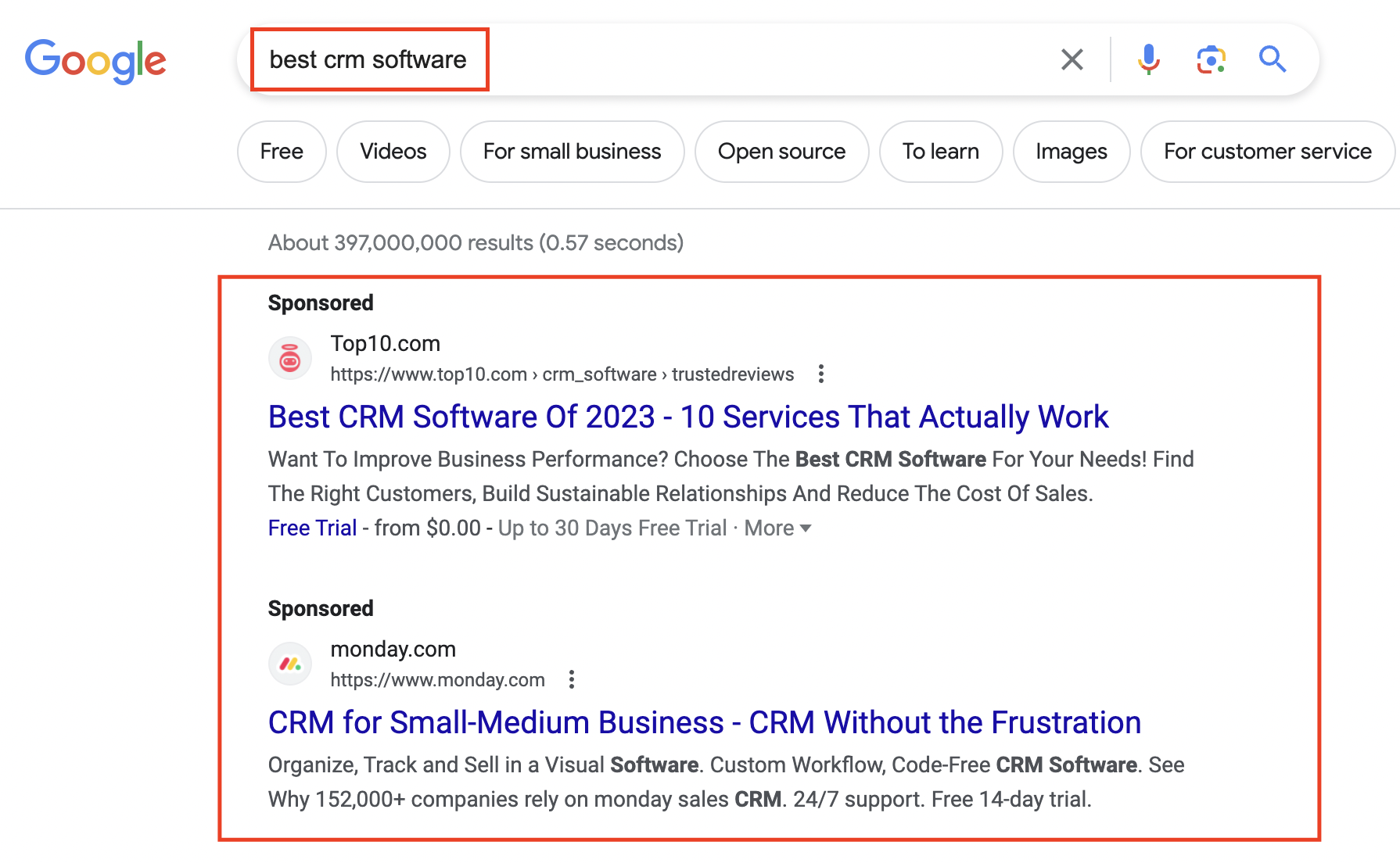
Display ads are visual banner ads that appear on websites within Google’s display network. This ad format is particularly effective when used for remarketing campaigns.
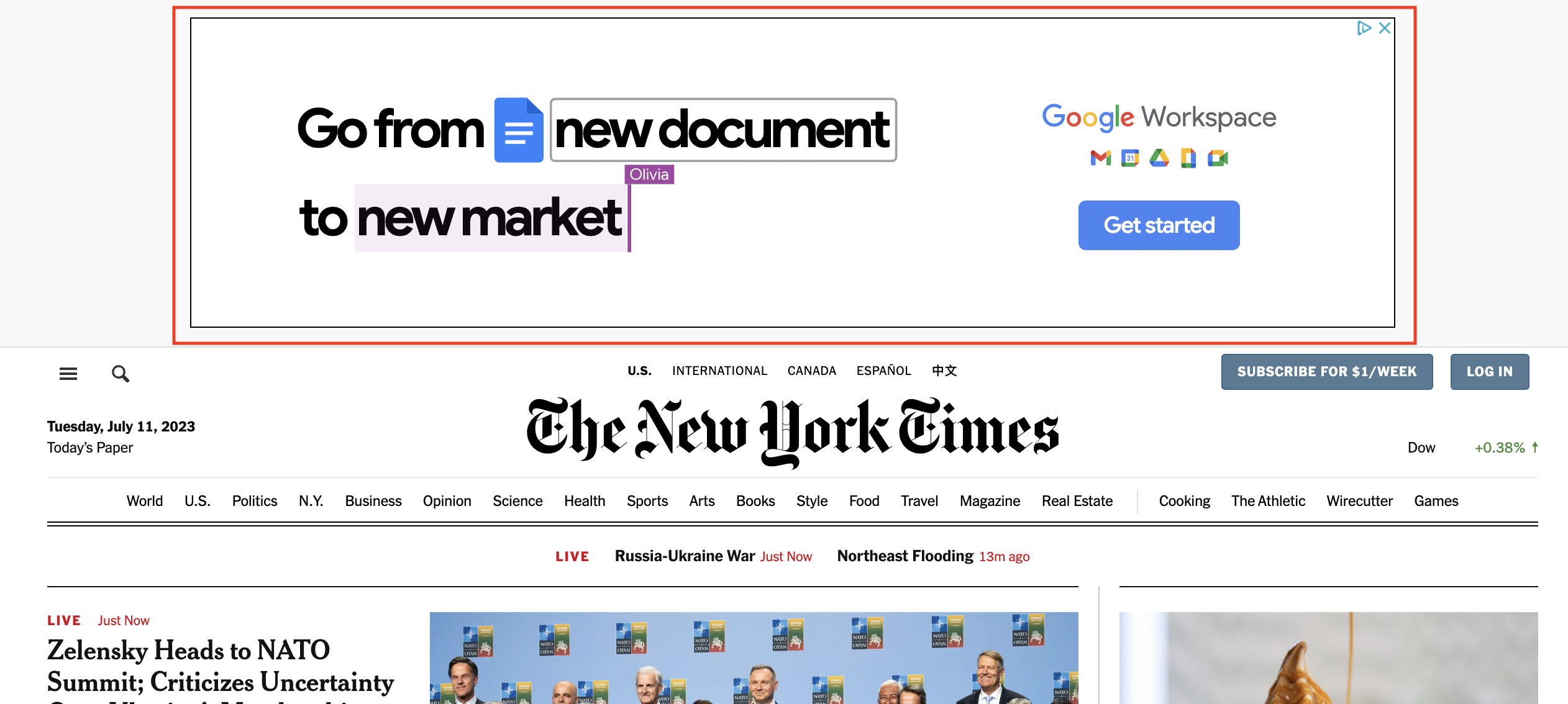
Video ads are played before or during YouTube videos, and alongside video thumbnails.
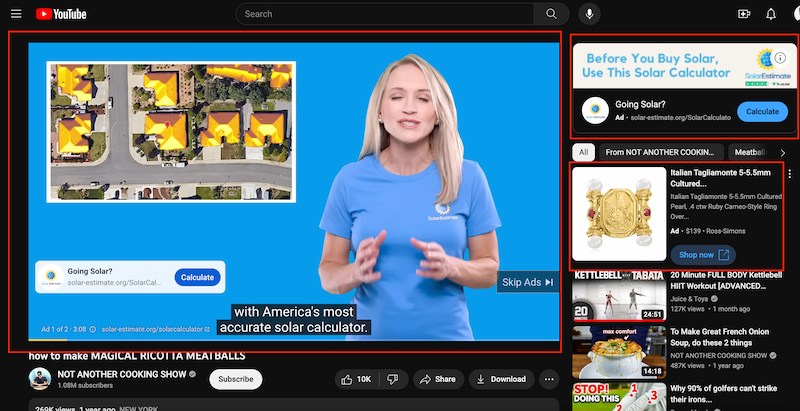
Shopping ads showcase products with images, prices, and descriptions. However – these ads are being phased out as Google moves shopping campaigns to performance max.
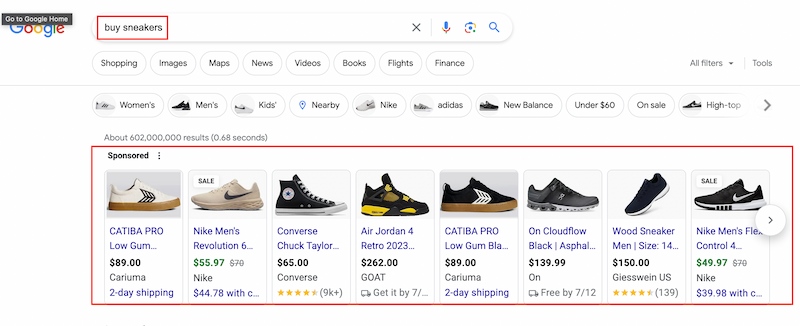
App ads promote mobile apps across various platforms, including Google’s search and display network, the Google Play Store and YouTube. These ads encourage a direct download of the app.
Performance max ads are a relatively new ad format, and allow advertisers to showcase their products or services in a visually engaging way across various Google platforms, including YouTube, Gmail, Discover, and Display Network.
This ad format uses machine learning algorithms to optimize ad performance by automatically choosing the best combination of assets (such as headlines, images, and descriptions) to deliver the most effective ad to each viewer. Interested in learning more about Performance Max? We’ve written extensively about it here.
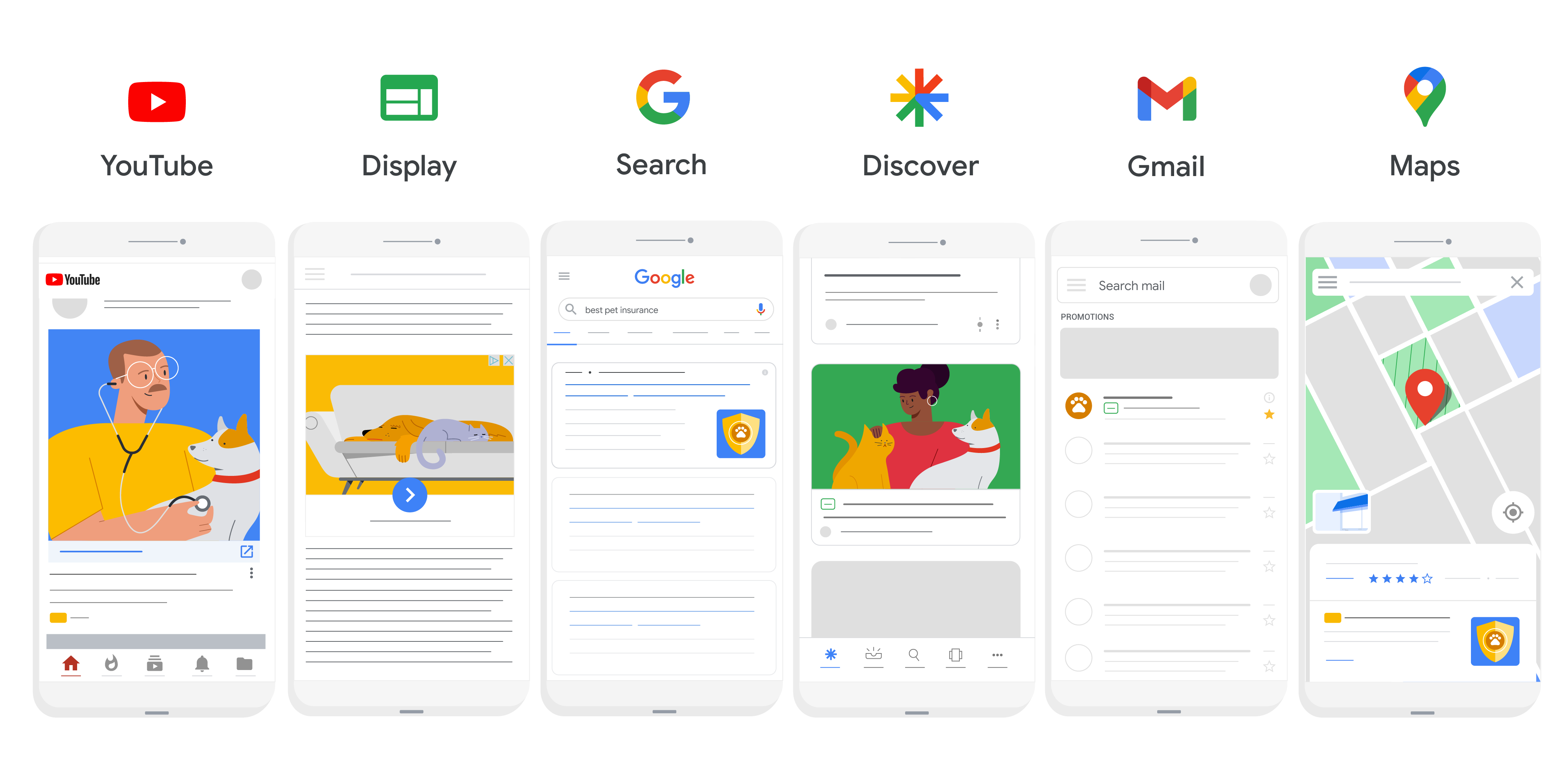
LinkedIn ad formats
LinkedIn ads mainly offer sponsored content, sponsored InMail, and text ads that appear on its social media feed and messaging feature.
Sponsored content appears in users’ news feeds. This ad format can include single image ads, video ads and carousels. It also supports lead gen forms – allowing advertisers to capture lead contact info directly from the LinkedIn feed, no landing pages needed.
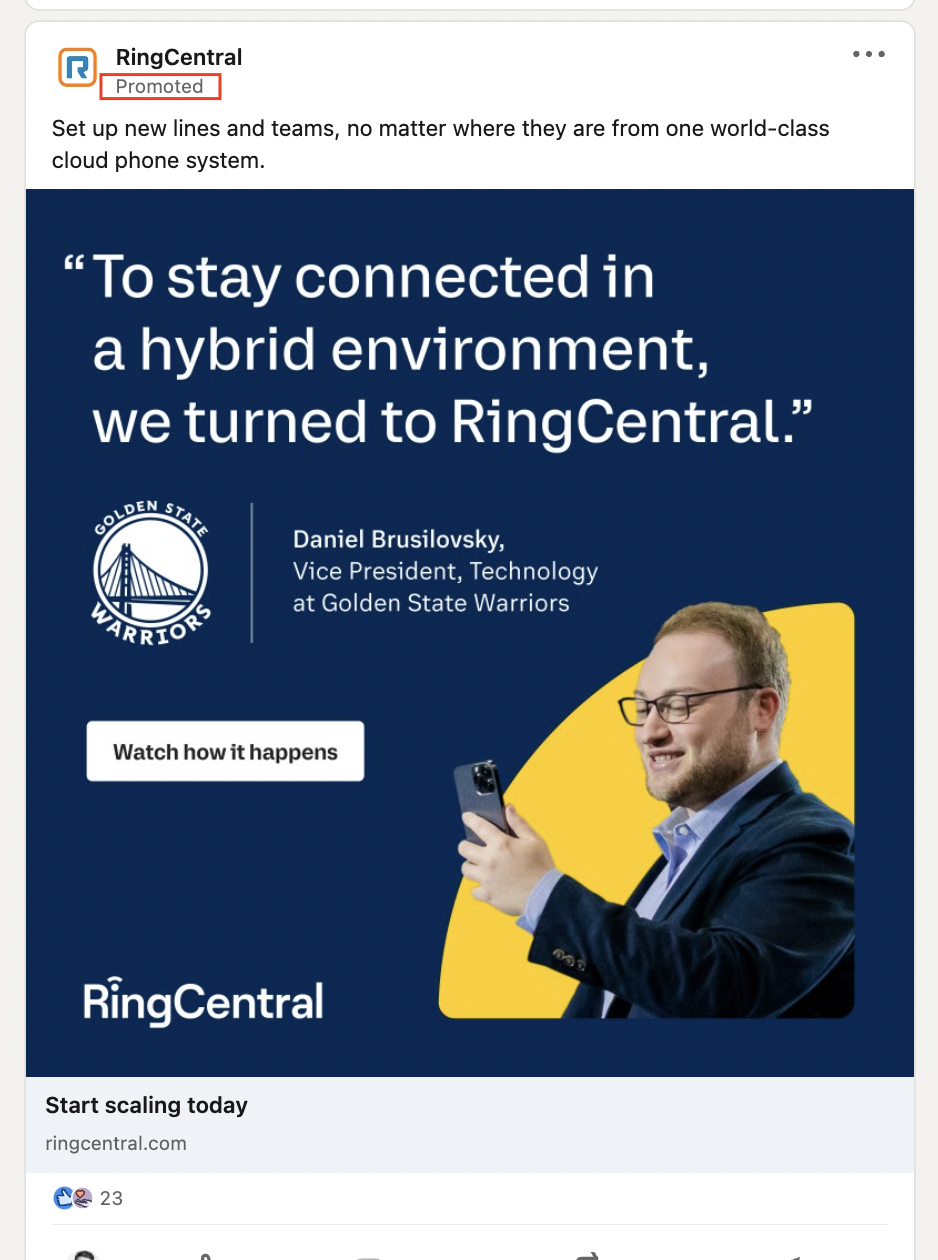
Sponsored InMail sends personalized messages to targeted users. This ad format includes Message ads, which are simply automated InMail messages to targeted personas, and Conversation ads, that offer message branching and multiple options to the persona, similar to a chatbot.
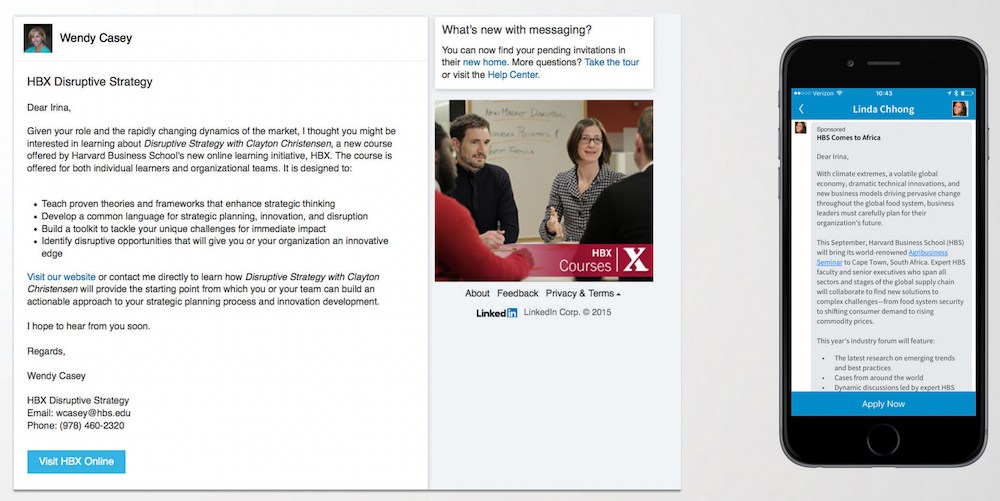
Text ads are displayed on the side or top of the LinkedIn feed.
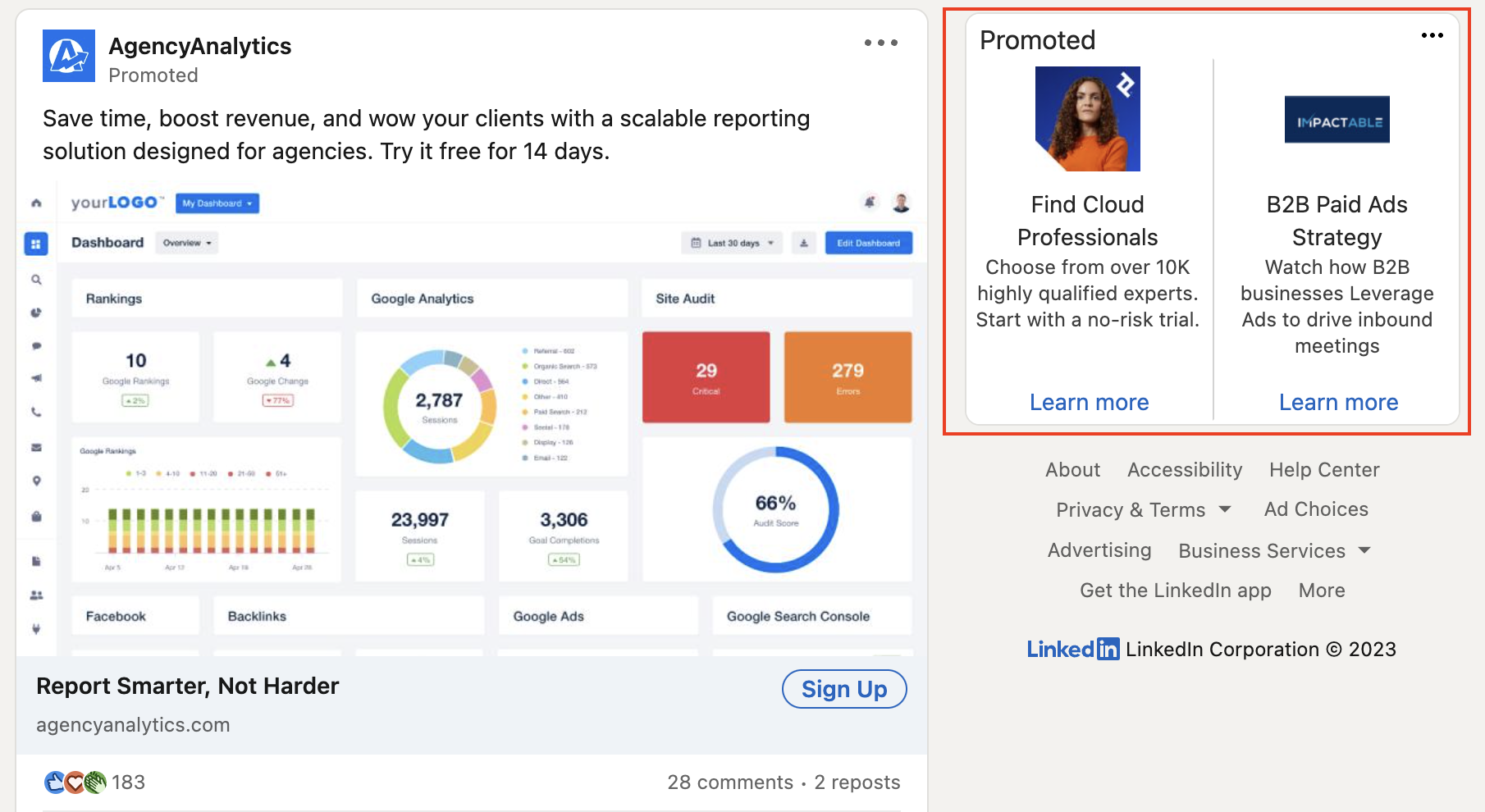
What industries are Google Ads good for?
B2B lead gen
Google Ads can be highly effective for generating B2B leads. It enables businesses to target specific keywords related to their product or service – no matter how niche.
This targeted approach ensures that ads are being shown to individuals who are actively searching for products or services related to the business.
It’s particularly effective for lead gen because people using search engines to find products or services are generally lower down the buying funnel than those served ads based on demographic or firmographic targeting. Remember: people on social media aren’t specifically looking to solve a problem when using the platform.
Additionally, Google Ads allows businesses to track and measure the success of their campaigns, providing valuable insights and data on lead generation. This data can then be used to optimize and refine future campaigns, improving overall lead generation efforts.
At a more sophisticated level, by connecting Google Ads to your CRM, or uploading offline sales data to your ad account – you can optimize campaigns around what’s driving sales opportunities and revenue for your business.
Local services companies
Local services companies like Construction, Roofing, Plumbing and HVAC firms find Google Ads incredibly effective for 2 reasons:
Firstly they can target people who are actively looking for the exact services they offer. For example a roofing company that only services commercial metal roofs can target a keyword like “commercial metal roof repair” to make sure their ad is only seen by relevant potential customers.
Secondly – Google’s geo-targeting options means that they can target ads to a precise catchment area. This prevents leads from calling the company outside of their areas of operation, and allows to them to build their brand in a local area.
eCommerce
Google Ads offers several valuable features for e-commerce and D2C brands. In particular, we love:
- Product Listing Ads: These allow advertisers to showcase products directly in search results.
- Dynamic Remarketing: Engage users who previously visited your website and viewed specific products or product types.
- Local Inventory Ads: Google Ads can be used to drive in-store visits or direct users to retail partners close to them – bridging the gap between online and offline commerce.
- Custom Audiences and Similar Audiences: Target existing customers and similar users.
- In-market Audiences: Reach users actively considering a purchase.
These features help e-commerce and D2C brands reach the right audience, promote products effectively, drive traffic, increase brand visibility, and boost sales. With the recent addition of Performance Max ad formats, the future is bright for ecomm companies using Google Ads.
What industries are LinkedIn Ads good for?
LinkedIn Ads are more of a niche product, and not a fit for every business. Don’t get us wrong – while Google Ads isn’t a fit for every business, it can work for most businesses. Some scenarios where Google Ads doesn’t work is where businesses aren’t able to invest the appropriate amount, or if they lack the sales infrastructure and discipline to close the leads generated from these campaigns.
Ok, so LinkedIn Ads aren’t for everyone. But what industries and business types do they work for?
Higher education
LinkedIn ads can be powerful for higher education advertisers, especially for MBA courses and other high-ticket education offerings. With LinkedIn’s extensive user base consisting of professionals and executives, advertisers can specifically target their ads towards individuals who are more likely to be interested in pursuing an MBA or other advanced education programs.
Ads can be tailored to reach a specific audience based on various criteria such as job title, industry, and educational background. This level of targeting ensures that the ads are shown to the most relevant and qualified candidates, increasing the chances of attracting potential students for these expensive programs.
Enterprise software
LinkedIn ads are particularly beneficial for enterprise software companies due to the platform’s unique targeting capabilities. With LinkedIn, businesses can effectively reach decision-makers and professionals within specific industries – making it easy to market industry or vertical-focused software and SaaS products.
Moreover, LinkedIn provides a professional environment where companies can showcase their expertise and establish their credibility, which is especially important for enterprise software companies looking to build their brand and influence with high-value prospects.
Professional services and consulting
Patience is a virtue, and while LinkedIn ads may not generate immediate leads, they can be incredibly valuable for nurturing brand awareness and building credibility within the professional community. For professional services and consulting firms that work with 6 and 7-figure contracts, keeping offerings top of mind with relevant decision makers is crucial.
Additionally, LinkedIn ads can be fantastic for Account-Based Marketing (ABM) strategies, since you can strategically target key decision-makers at specific companies and guide them further down the sales funnel.
Unlike other social media platforms, LinkedIn allows you to target specific professional demographics such as job titles, industries, company sizes, and more. This level of precision ensures that ads for professional services and consulting are reaching the right audience, increasing the likelihood of engagement and conversions.
Events and conferences
LinkedIn ads can be an effective tool for promoting events and conferences. By using the platform’s advanced targeting options, businesses can reach a specific audience of professionals who are more likely to be interested in attending such events.
These ads can be tailored to showcase key details, such as date, location, and featured speakers, to generate interest and encourage registrations.
Using LinkedIn ads for events and conferences can not only increase brand visibility but also attract a highly engaged and relevant audience, ultimately leading to a more successful and impactful event.
Comparing Google Ads vs. LinkedIn Ads
Audience
While Google is a swiss-army knife that can be used for all kinds of businesses. LinkedIn does one thing (targeting certain professionals in specific industries), and it does it very, very well.
Google Ads audience
With Google Ads – the world is literally your oyster. Google is used by almost every internet user you’d want to speak to (sorry Bing, we know you’re great too). With billions of searches daily for a plethora of different queries, across almost everywhere on earth, Google probably has the audience you want.
LinkedIn Ads audience
While Google is massive, don’t discount LinkedIn – this budding social media giant boasts 930 million members in more than 200 countries and territories worldwide. However – the audience skews more professional, more business-oriented and more highly educated than any other social media platform or search engine.
Targeting options
Targeting works pretty differently for each channel. Google offers a mix of intent-based and demographic targeting, while LinkedIn adds some business-specific capabilities, let’s dive in:
Google Ads targeting
Google targeting allows you to target by keywords, but also supports demographic, interest and geo-targeting settings to hone in on a specific audience.
LinkedIn Ads targeting
LinkedIn Ads offer the same demographic targeting of many channels, but what makes it unique is it’s firmographic targeting abilities. This firmographic data includes company industry, number of employees and revenue.
A note on retargeting
Note that both Google and Linkedin both have comprehensive retargeting options that allow advertisers to serve ads to people that have viewed certain pages on their website, have made purchases previously, or interacted with the business in some fashion. This can be either cookie-based or email-based (using a customer list) on both platforms.
Analytics & Reporting
Google Ads analytics and reporting

This is one major strength of Google Ads – it has arguably the best reporting and analytics features of any online ad channel (we’re looking at you Facebook ads).
With extensive Prebuilt reports, and infinite combinations of custom reports ready to be created, Google Ads is a playground for the data-obsessed. You can also quickly export reports to CSV for deeper analysis, export pdf’s for executive or client review, schedule reports to run automatically on a set cadence and pipe data to Looker Studio (formerly known as Google Data Studio) with a native integration. Nifty, right?
There’s many ways to skin a cat, but there may be even more ways to examine, explore and digest data from Google Ads. And reporting is relatively easy to configure, with a simple UX and not much of a learning curve. Slice and dice with columns galore in a pivot table, or use native reports to quickly examine KPIs.
LinkedIn Ads analytics and reporting
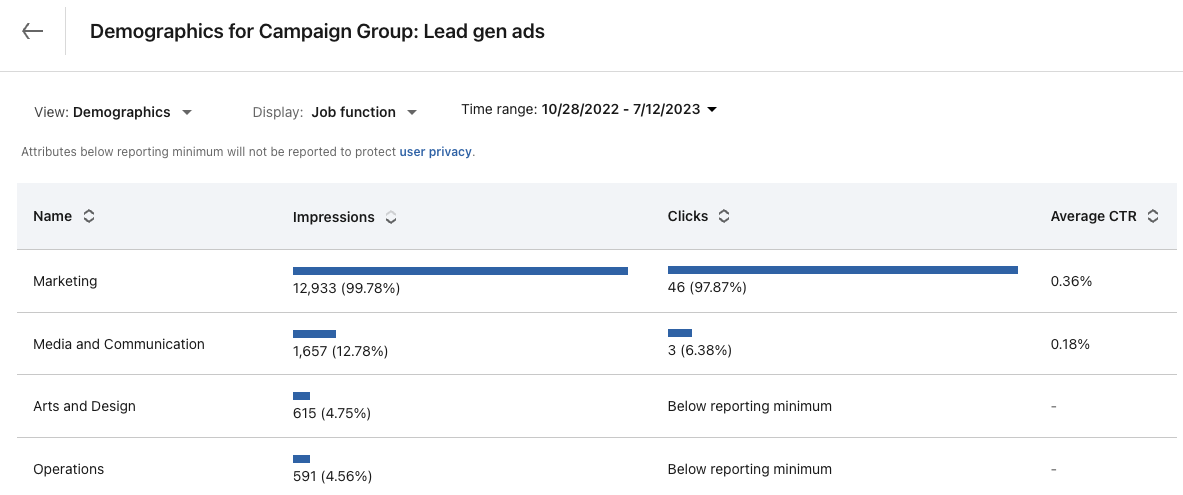
Frankly, LinkedIn Ads isn’t nearly as good at Google Ads when it comes to analytics and reporting capabilities. It’s more limited, and you don’t get massive insights beyond core performance KPIs (CPC, CTR, Impressions etc.)
However – what makes LinkedIn ads reporting powerful is that it allows you to much better understand who has been served your ads, and what types of companies (industry, headcount etc.) they work for.
These audience insights are valuable for refining targeting and tailoring ad content to resonate with your desired audience, and making sure that you’re reaching the right demographics with your campaigns.
Are LinkedIn or Google Ads more effective for B2B marketing?
Both platforms have their merits, but if you’re looking for unparalleled reach, strong buyer intent, and exceptional scalability, Google Ads takes the lead. However, LinkedIn Ads excels in reaching niche audiences.
Let’s explore why Google Ads reigns supreme while acknowledging the strengths of LinkedIn Ads:
Google has insane reach
Google Ads boasts an extensive network that spans search, display networks, and YouTube. With billions of daily searches, your brand can establish a dominant presence across the digital landscape. Google makes it easy to reach potential B2B buyers far and wide, ensuring your message resonates at the right time and place.
Google is easier to scale
Google Ads provides abundant opportunities for scaling your B2B marketing efforts. Once you’ve dialed in a solid baseline of performance, you can add incremental budget to tap into its vast network, easily expand campaigns to cover new keyword themes, and venture into new markets. This flexibility empowers your business to grow exponentially and scale customer acquisition efforts quickly.
ABM opportunities on LinkedIn
LinkedIn Ads provides unparalleled access to a highly targeted business audience. It’s a treasure trove for reaching niche markets and connecting with decision-makers and industry professionals. Leveraging LinkedIn’s Account-Based Marketing (ABM) features, you can create personalized campaigns that resonate deeply with your specific target audience.
Target by intent on Google Ads
With B2B Google Ads, you can target audiences based on their intent, allowing you to connect with prospects actively seeking solutions. By aligning your offerings with their needs, you maximize your chances of converting leads into customers. It’s a powerful tool to engage with potential buyers when they are most receptive.
Target competitors effectively on Google Ads – bid on brand terms
You can gain a strategic advantage with Google Ads by bidding on your competitors’ brand name. By positioning your brand in front of their audience, you steal the spotlight and entice potential buyers with your offerings. This cheeky tactic allows you to outshine the competition and capture additional market share.
It can be particularly powerful to position your product as ‘the alternative’. You can’t explicitly mention trademarks in your ad copy, but you can get creative with insinuation and suggestion. However, on your landing pages you can illustrate how your product or service is a better fit and what features outshine your competitors.
LinkedIn Ads and Google Ads are formidable B2B marketing platforms, each with their own strengths
When it comes to reaching a vast audience, targeting buyers with intent, and scaling your campaigns, Google Ads takes the lead. Compared to Google or even Facebook, LinkedIn is more of an add-on channel than a core acquisition channel. Nevertheless, LinkedIn Ads shines in reaching niche audiences and executing laser-focused targeting.
Are LinkedIn or Google Ads more effective for B2C marketing?
When it comes to B2C marketing, Google Ads is the unrivaled powerhouse, offering vast consumer reach, unparalleled user intent targeting, and remarkable scalability. While LinkedIn Ads has its merits, it falls short in meeting the demands of B2C advertisers.
Facebook ads are a worthy competitor for Google Ads’ B2C throne – but that’s a whole other blog post. Let’s explore the advantages of Google Ads for B2C marketers, and understand why it reigns supreme:
Google Ads for B2C:
Pros:
- Reach the Masses: Google Ads provides an expansive network encompassing search, display networks, and YouTube, granting access to an extensive consumer audience. With the ability to reach and engage consumers across multiple touchpoints, Google Ads ensures maximum brand visibility and immense potential for conversions.
- User Intent Targeting: Leveraging user search queries and browsing behavior, Google Ads allows precise targeting based on user intent. By strategically positioning your offerings in front of consumers actively searching for products or services similar to what you offer, you significantly increase the likelihood of capturing highly interested and motivated buyers.
- Scalability: Google Ads offers unmatched scalability for B2C marketing campaigns. Whether you intend to increase customer growth, expand reach, or tap into new markets, the platform provides the necessary flexibility and tools to nail your growth objectives. And with the addition of Performance Max campaigns – Google is becoming even more effective for eCommerce and D2C advertisers.
Cons:
- Limited Professional Targeting: While LinkedIn Ads excels in targeting specific professional demographics or interests, Google Ads has some limitations in that regard. B2C businesses focusing on niche markets or professionals with specific career-based preferences might find it challenging to reach their desired audience through Google Ads alone. That being said, these demographics can usually be found on other platforms or by creative targeting, so it’s not a huge issue.
- Increased Competition: Due to its popularity, Google Ads attracts intense competition for top ad placements. This competition can drive up costs per click and require ongoing optimization efforts to maintain a strong position. Advertisers must actively manage budgets and bid strategies to ensure cost-effectiveness. Generally, industry-wide cost per conversion goes up yearly with Google, as markets become saturated with new advertisers.
LinkedIn Ads for B2C:
Pros:
- Niche Audience Targeting: LinkedIn Ads provides access to a highly targeted audience of professionals, which can be advantageous for B2C businesses going after super niche segments or specialized professional audiences. If your B2C marketing strategy focuses on specific industries, professionals, or specialized interests, LinkedIn Ads allows you to reach and engage with this specific audience effectively.
Cons:
- Limited Consumer Reach: Unlike Google Ads, LinkedIn Ads has limited reach when it comes to reaching a broad consumer audience. If your B2C marketing strategy revolves around capturing a mass market or targeting a wide consumer base, LinkedIn Ads may not provide the extensive audience reach needed to maximize your campaign’s impact.
- Higher Cost Per Click: Compared to some other advertising platforms, LinkedIn Ads generally has a higher cost per click. This can impact the overall campaign budget and may require careful optimization and targeting to ensure cost-effectiveness in B2C marketing scenarios.
For B2C advertisers, the undeniable power of Google Ads cannot be overstated. With its unmatched consumer reach, precision user intent targeting, and exceptional scalability, Google Ads empowers B2C brands to achieve a better ROI than almost any other marketing channel.
And while LinkedIn Ads has its place in hyper-specific B2B contexts, it falls short when it comes to meeting the demands of B2C advertisers.
How to decide on Google Ads vs. LinkedIn Ads?
Ok so if you’ve made it this far, you should have a pretty good handle on which ad channel is likely a better fit for your business.
But there are some nuances to consider when deciding whether Google Ads or LinkedIn ads is a better marketing channel for your business – without further ado, let’s dive in:
What are your campaign goals – lead gen or brand awareness?
Before spending a penny, it’s crucial to clarify your campaign goals. If your primary objective is lead generation, both platforms offer effective solutions, but with different approaches. Google Ads excels in capturing intent-driven leads through search queries, while LinkedIn Ads allows for targeted lead generation by reaching a specific professional audience.
On the other hand, if your focus is on brand awareness, both platforms can help, but Google Ads offers broader reach across its extensive network, including search, display, and video.
Business maturity
For businesses at the early stages of their marketing efforts, it’s generally recommended to start with Google Ads due to its massive reach and faster results.
Google Ads allows you to quickly gauge campaign performance, optimize strategies, and generate valuable data insights.
Once you’ve established a strong foundation and understood your marketing budget ROI, you can consider adding LinkedIn Ads as a testing channel with a small initial percentage of spend, particularly if your target audience aligns with the platform’s professional network.
Sales motion
Consider your sales motion when choosing between Google Ads and LinkedIn Ads. If your business operates on a self-serve model or focuses on quick, self-driven purchases, Google Ads may be the ideal choice. It allows you to capture potential customers at the moment of intent and drive immediate conversions.
Conversely, if your sales process requires a more consultative, hands-on approach with a handoff to a sales team, LinkedIn Ads can be effective in reaching professionals who may be involved in the decision-making process. This harks back to our note on ABM – if you want to target certain accounts specifically, LinkedIn is a great choice.
Average deal size
Average ticket size (for both products and services) is an essential factor in deciding between Google Ads and LinkedIn Ads. Google Ads can cater to a wide range of ticket sizes, from small-ticket clothing purchases to multi-million dollar consulting leads.
LinkedIn Ads is often better suited to higher ticket products or services due to its higher CPCs and overall higher cost per leadm which makes the unit economics hard to justify for small purchases. If your offering carries a substantial price tag, LinkedIn Ads can help you target a professional audience with a higher likelihood of being a decision maker – particularly useful for high value B2B leads.
Sales cycle
Consider the length of your sales cycle when choosing between the platforms. If your sales cycle is short and requires quick conversions, Google Ads can deliver results in a matter of weeks or even days. Conversely, if your sales cycle is longer, involving multiple touchpoints and a nurturing process, LinkedIn Ads can be valuable for maintaining visibility and engaging with your target accounts over an extended period.
Target audience (broad vs. niche)
Identify whether your target audience is broad or niche. Google Ads allows you to reach a broad consumer audience across various industries and interests. It’s suitable for casting a wide net and capturing potential customers who may be searching for products or services related to your offering.
LinkedIn Ads, on the other hand, shines in reaching niche professional audiences, allowing you to target specific industries, job titles, or interests. It’s an excellent option if your target audience is more specialized and concentrated. For example if you only serve a certain industry, vertical or company size.
Marketing budget
Obviously, you have to consider your budget first when selecting any ad platform. And it’s important to allocate a budget that aligns with your goals and expectations for each platform, otherwise there’s a risk of ending up with a false negative signal that the channel is ineffective.
Google Ads can accommodate smaller budgets and still yield results, making it suitable for businesses with limited resources. However, keep in mind that to see significant impact and maintain competitiveness, a certain level of investment is necessary. LinkedIn Ads generally comes with higher costs, including higher CPCs and overall cost per lead that necessitate more budget outlay to see success.
Time to results tolerance
Evaluate your tolerance for time to results. If you require relatively quick outcomes, Google Ads is the preferred choice. With its broad reach and immediate visibility, you can expect to see tangible results within weeks or even days.
Conversely, LinkedIn Ads may take longer to yield measurable results due to its narrower audience focus and professional targeting. It requires patience and a longer-term approach to nurturing relationships. It’s also a discovery-based platform, so the folks seeing your ads might not necessarily be in market for your product or services.
When deciding between Google Ads and LinkedIn Ads, it’s crucial to align your campaign goals, business maturity, sales motion, average deal size, sales cycle, target audience, budget, and time to results tolerance with the strengths and capabilities of each platform.
Which platform is easier to manage?
Google Ads – A World of Granularity
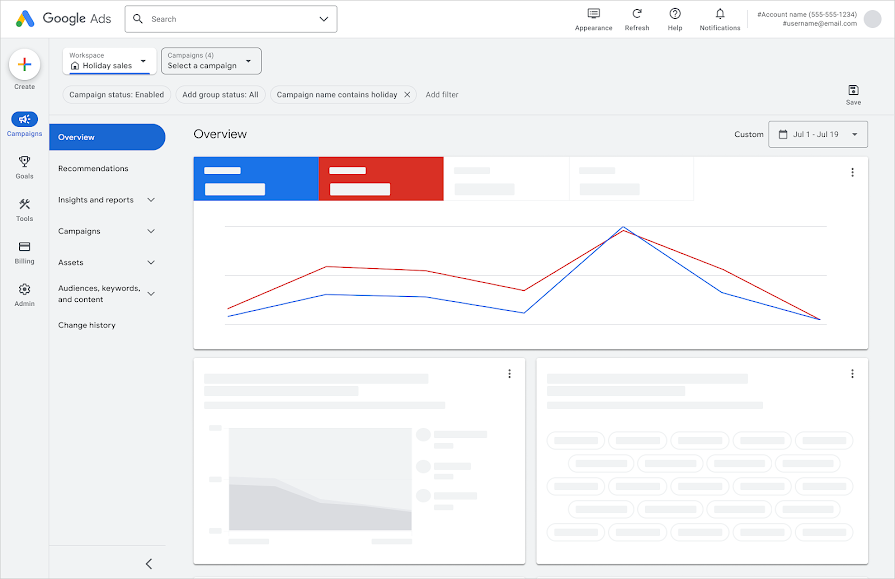
Google Ads offers a wealth of granularity, providing advertisers with thousands of tweaks, settings, and options to optimize their campaigns.
With its robust platform, advertisers have the ability to fine-tune their targeting, bidding strategies, ad formats, and ad extensions to achieve their desired outcomes.
This level of control allows for precise campaign management and the flexibility to adapt and optimize strategies based on real-time performance data. Luckily there are expert PPC consulting agencies (like Velocity), to help you manage this complexity, and even some Google Ads tools that help with day-to-day management.
LinkedIn Ads – Streamlined Campaign Setup with Creative and Targeting Focus
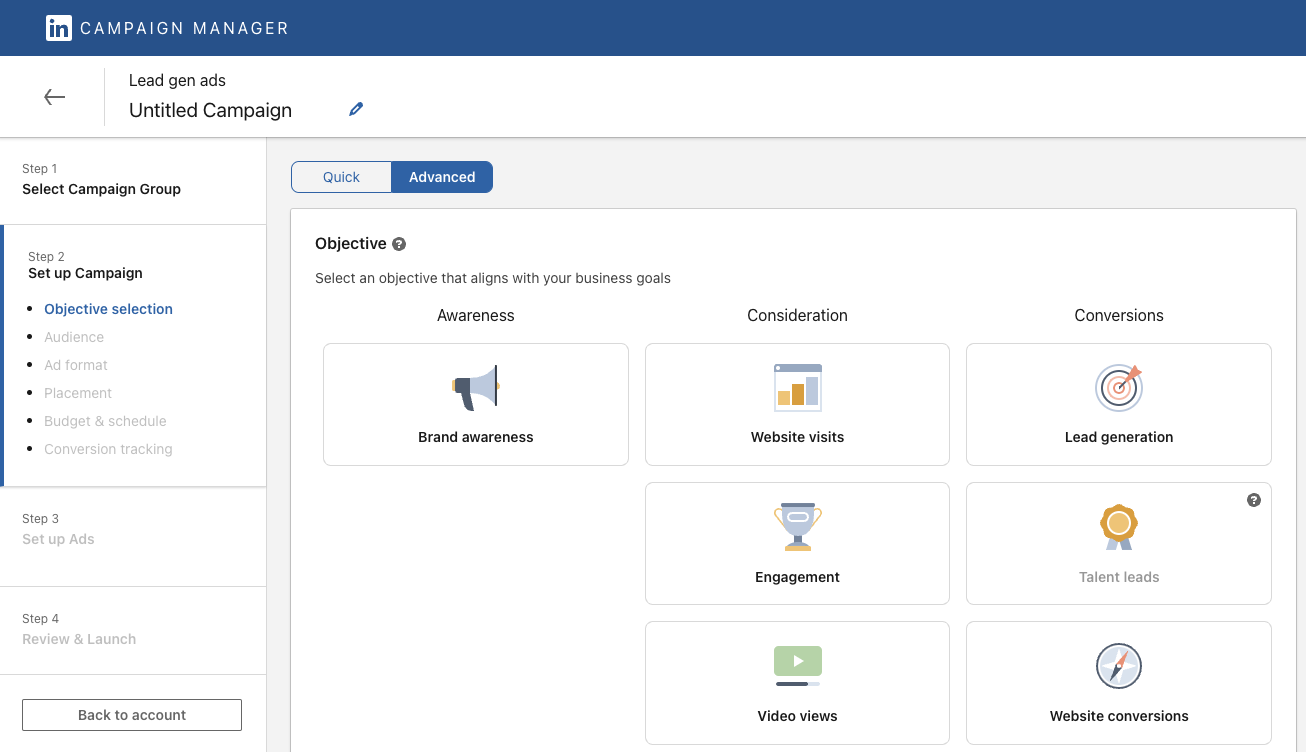
LinkedIn Ads, in contrast, offers a simpler campaign setup process that places greater emphasis on creative elements and targeting. While the platform may not offer the same level of granular control as Google Ads, it streamlines the campaign creation process, making it more accessible for advertisers.
LinkedIn Ads places significant importance on creative components, such as ad copy, visuals, and messaging, enabling advertisers to craft compelling campaigns that resonate with their target professional audience. While LinkedIn’s precise targeting allows marketers to dial in experiments and test how this creative resonates with them.
When comparing the ease of management between the two platforms, it’s important to consider the specific needs and preferences of your advertising strategy:
- If you value extensive control and enjoy delving into a multitude of options to optimize your campaigns, Google Ads provides the ideal playground for granular campaign management. The platform’s robust features and extensive settings offer a high level of customization and control. That being said Google’s new Performance Max campaigns are making campaign creation easier than ever.
- On the other hand, if you prefer a streamlined campaign setup and believe that the creative elements play a pivotal role in driving engagement and conversions, LinkedIn Ads provides a simpler management experience. While it may not offer the same level of fine-grained control as Google Ads, its emphasis on creative aspects allows for a more straightforward approach to campaign management, while it’s targeting options allow B2B advertisers to thrive.
Ultimately, the ease of management depends on your level of comfort with in-depth customization, your campaign objectives, and the importance you place on creative elements within your advertising strategy.
Both channels can be relatively simple or complex – depending on what scale you are advertising at!
Conclusion
In the realm of digital advertising, both Google Ads and LinkedIn Ads have proven effective for B2B marketers. And B2C advertisers can find exceptional value in leveraging the versatility and wide consumer reach of Google Ads.
On the other hand, LinkedIn Ads caters to industry-specific campaigns, providing a focused approach that resonates with niche markets and specialized professional audiences.
To determine the ideal platform for your advertising needs, it is crucial to evaluate your objectives, target audience, and overall marketing channel mix. While also considering your business maturity, sales motion and operational limitations. There’s a lot to consider when comparing google ads vs linkedin ads, but we hope this article gives you the foundational understanding and talking points you need to help steer your decision.
Interested in optimizing these channels or adding them to your arsenal? Get in touch for a free strategy session today! We’d love to chat and help you decide which is the best fit.
